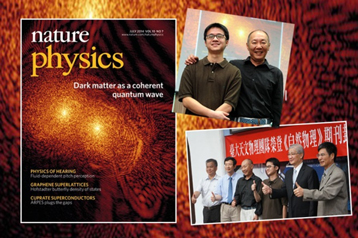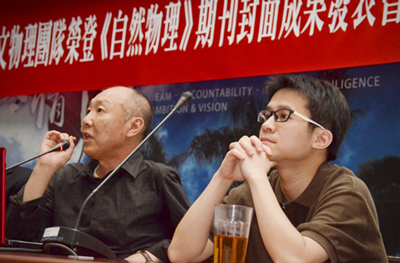

 |
||
|
::: Groundbreaking Dark Matter Research Makes Cover of International Physics Journal |
||
 NTU Department of Physics’ paper on dark matter is featured as the cover of the 2014 July issue of Nature Physics.  Authors Prof. Chiueh (left) and Dr. Schive (right) present their findings at a press conference at NTU on July 2. A research team from National Taiwan University in collaboration with the University of Basque (UPV/EHU) recently discovered that an extremely light dark matter can potentially solve the inconsistency problems pertaining to dwarf galaxy observations encountered by traditional studies based on massive dark matter. The study, conducted by NTU Department of Physics’ Dr. Hsi-Yu Schive (薛熙于) and Professor Tzi-Hong Chiueh (闕志鴻), and UPV/EHU Theoretical Physics’ Professor Tom Broadhurst, differs from previous notions of the “massive” dark matter in arguing that the extremely light dark matter (dubbed ψDM), whose particle is 10-28 times lighter than the electron, make up the majority of matter in the Universe as it is incredibly dense and copious. The study also found evidence of the intriguing connection between the cosmic dark matter and the supermassive black holes (SMBH) found at every galaxy nucleus. This, according to the researchers, presents a potential path to solving previously unanswered questions pertaining to the relation and influences between solitons and the SMBH. To further analyze its findings, the team built a 64-graphic card cluster computational instrument specifically for the project. The graphic-card cluster was donated to the team in 2013 by Chip-Bond Technology Inc. The research team is the first in the world to conduct such ψDM simulations for the local universe. As a result, the breakthrough was published in and made the cover of the esteemed physics journal Nature Physics on July 1, 2014 under the title “Cosmic Structure as the Quantum Interference of a Coherent Dark Wave.” Dr. Hsi-Yu Schive is a world-leading expert in graphic-card accelerated computation. Professor Tzi-Hong Chiueh is an NTU alumnus and expert in astrophysics and the dynamics of evolution. He is currently a Distinguished Professor at the Department of Physics. For more information on the study, read the full paper HERE. |
||
No. 1, Sec. 4, Roosevelt Road, Taipei, 10617 Taiwan(R.O.C.)
Phone: +886-2-3366-3366 Fax: +886-2-2362-7651